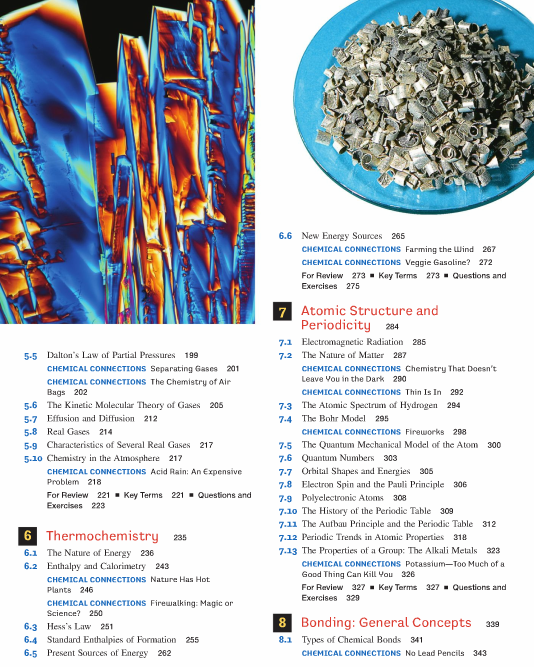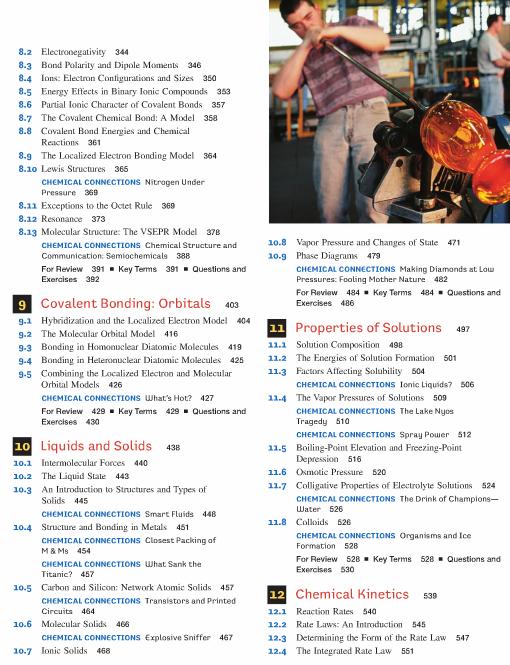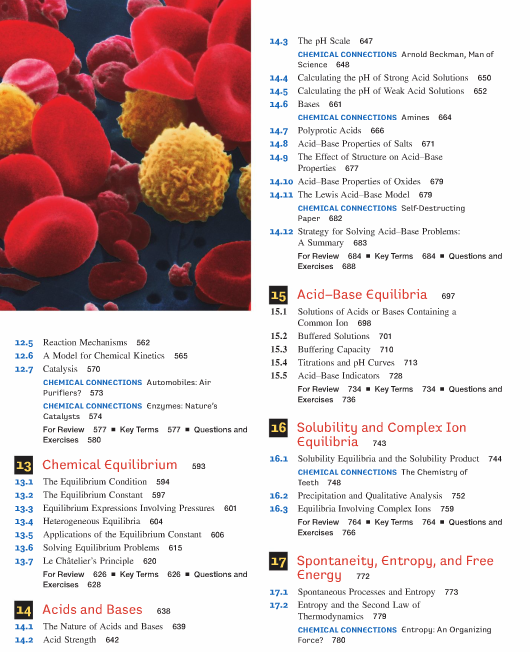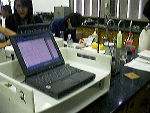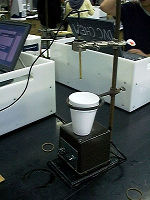 Chem 120 Topics & Assignments:
Chem 120 Topics & Assignments:
Reading / Homework / Experiments & Activities
• 2. Atoms, Molecules, and Ions
2.1 The Early History of Chemistry
|
|
2.2 Fundamental Chemical Laws
|
|
2.3 Dalton's Atomic Theory
|
|
2.4 Early Experiments to Characterize
the Atom
|
|
2.5 The Modern View of Atomic
Structure: An Introduction
|
|
2.6 Molecules and Ions
|
|
2.7 An Introduction to the Periodic
Table
|
|
| 2.8 Naming Simple Compounds |
|
• 3. Stoichiometry
3.1 Counting by Weighing
|
|
3.2 Atomic Masses
|
|
3.3 The Mole
|
|
3.4 Molar Mass
|
|
3.5 Percent Composition of Compounds
|
|
3.6 Determining the Formula of
a Compound
|
|
3.7 Chemical Equations
|
|
3.8 Balancing
Chemical Equations
|
|
3.9 Stoichiometric
Calculations: Amounts of Reactants and Products
|
|
| 3.10 Calculations
Involving a Limiting Reactant |
|
• 4. Types of Chemical Reactions and Solution Stoichiometry
4.1 Water, the Common
Solvent
|
|
4.2 The
Nature of Aqueous Solutions: Strong and Weak Electrolytes
|
|
4.3 The
Composition of Solutions
|
|
4.4 Types
of Chemical Reactions
|
|
4.5 Precipitation
Reactions
|
|
4.6 Describing
Reactions in Solution
|
|
| 4.7
Stoichiometry of Precipitation Reactions |
|
4.8
Acid-Base Reactions
|
|
4.9
Oxidation-Reduction Reactions
|
|
| 4.10
Balancing Oxidation-Reduction Equations |
|
• 5. Gases
5.1 Pressure
5.2 The Gas Laws of Boyle, Charles, and Avogadro
5.3 The Ideal Gas Law
5.4 Gas Stoichiometry
5.5 Dalton's Law of Partial Pressures
5.6 The Kinetic Molecular Theory of Gases
5.7 Effusion and Diffusion
5.8 Real Gases
5.9 Chemistry in the Atmosphere
5.10 Characteristics of Several Real Gases
|
http://chemwiki.ucdavis.edu/Wikitexts/UCD_Chem_2A
* Gas Pressure
* Virtual: Pressure
* Gas Laws
* Dalton's Law
* Virtual: Dalton's Law
* Virtual: Avogadro's Law
* Virtual: Boyle's Law
* Virtual: Boyle's Law Calculations
* Virtual: Charles's Law
* Ideal Gas Law and the Gas Constant
* Ideal Gas Equation
* Chemical Reactions in Gas Phase
* Gas Mixtures
* Kinetic Theory of Gases
* Connecting Gas Properties to Kinetic Theory of Gases
* Non-Ideal Gases
* Case Study: Contrasting Earth, Mars and the Moon's Atmospheres
|
• 6. Thermochemistry
6.1 The Nature of Energy
6.2 Enthalpy and Calorimetry
6.3 Hess's Law
6.4 Standard Enthalpies of Formation
6.5 Present Sources of Energy
6.6 New Energy Sources
|
http://chemwiki.ucdavis.edu/Wikitexts/UCD_Chem_2B%3a_Madsen/Thermodynamics_and_ThermoChemistry
Definitions and Basic Principles
* System and its Surroundings
* Path Functions
* Heat
* Work
* State Functions
* Kinetic Energy
* Potential Energy
* Thermal Energy
* Internal Energy
* Chemical energy
Principles of Thermodynamics
* First Law of Thermodynamics
* Second Law of Thermodynamics
* Third Law of Thermodynamics
* Calorimetry
o Constant Volume (Bomb) calorimetry
o Constant Pressure calorimetry
* Heat capacity
* Delta H and Temperature
* Hess' Law
* Energy Level Diagrams
* Gas Expansion
Enthalpy
* Heat of Reaction
* Standard Enthalpy of Formation
* Enthalpy Of Vaporization
Fuels
* Fossil Fuels
* Solar Energy
|
• 7. Atomic Structure and Periodicity
7.1 Electromagnetic
Radiation
7.2 The Nature of Matter
7.3 The Atomic Spectrum of Hydrogen
7.4 The Bohr Model
7.5 The Quantum Mechanical Model of the Atom
7.6 Quantum Numbers
7.7 Orbital Shapes and Energies
7.8 Electron Spin and the Pauli Principle
7.9 Polyelectronic Atoms
7.10 The History of the Periodic Table
7.11 The Aufbau Principles and the Periodic Table
7.12 Periodic Trends in Atomic Properties
7.13 The Properties of a Group: The Alkali Metals
|
http://chemwiki.ucdavis.edu/Wikitexts/UCD_Chem_2A
Electrons in Atoms
* Electromagnetic Radiation
* Atomic Spectra
* Quantum Theory
* The Bohr Atom
* Wave-Particle Duality
* Uncertainty Principle
* Wave Mechanics
* Quantum Numbers
* Electronic Orbitals
* Electron Spin
* Multi-electron Atoms
* Electronic Configurations
* Aufbau Principle
* Hund's Rules
* Pauli Exclusion Principle
* Connecting Electronic Configurations to the Periodic Table
# The Periodic Law
# Metals and Nonmetals and Their Ions
# Atomic Radii
# Ionization Energy
# Electron Affinity
# Magnetic Properties
# Periodic Properties of the Element
|
• 8. Bonding: General Concepts
8.1 Types of Chemical
Bonds
8.2 Electronegativity
8.3 Bond Polarity and Dipole Moments
8.4 Ions: Electron Configurations and Sizes
8.5 Formation of Binary Ionic Compounds
8.6 Partial Ionic Character of Covalent Bonds
8.7 The Covalent Chemical Bond: A Model
8.8 Covalent Bond Energies and Chemical Reactions
8.9 The Localized Electron Bonding Model
8.10 Lewis Structures
8.11 Exceptions to the Octet Rule
8.12 Resonance
8.13 Molecular Structure: The VSEPR Model
|
http://chemwiki.ucdavis.edu/Wikitexts/UCD_Chem_2A
* Lewis Theory of Bonding
* Covalent Bonds
* Electrostatic Potential maps
* Lewis Structures
* Resonance
* Octet Rule Violations
* Geometry of Molecules
* Bond Order and Lengths
* Bond Energies
* Valence Bond Theory
* Hybridization
* Non-Singular Covelent Bonds
* Molecular Orbital Theory
* Delocalization of Electrons
* Metallic Bonding
|
• 9. Covalent Bonding: Orbitals
9.1 Hybridization and the Localized Electron Model
9.2 The Molecular Orbital Model
9.3 Bonding in Homonuclear Diatomic Molecules
9.4 Bonding in Heteronuclear Diatomic Molecules
9.5 Combining the Localized Electron and Molecular Orbital Models
• 10. Liquids and Solids
10.1 Intermolecular Forces
10.2 The Liquid State
10.3 An Introduction to Structures and Types of Solids
10.4 Structure and Bonding in Metals
10.5 Carbon and Silicon: Network Atomic Solids
10.6 Molecular Solids
10.7 Ionic Solids
10.8 Vapor Pressure and Changes of State
10.9 Phase Diagrams
|
http://chemwiki.ucdavis.edu/Wikitexts/UCD_Chem_2B
States of Matter
States of Matter and Intermolecular Forces
* Phase Transitions
Intermolecular Interactions
* Intermolecular Forces
* Van der waals Forces
* Polarizability
Hydrogen Bonding
* Hydrogen Bonding
Liquids
* Surface Tension
* Capillary Action
* Viscosity
* Vapor Pressure
* Enthalpy of Vaporization
* Boiling
* Critical Point
* Heat of Fusion
* Phase Diagrams
Supercritical fluids
Solids
* Network covalent solids
* Ionic Solids
* Crystal Lattice
* Closest Pack Structures
* Bragg’s law
* Unit cells
|
• 11. Properties of Solutions
11.1 Solution Composition
11.2 The Energies of Solution Formation
11.3 Factors Affecting Solubility
11.4 The Vapor Pressures of Solutions
11.5 Boiling-Point Elevation and Freezing-Point Depression
11.6 Osmotic Pressure
11.7 Colligative Properties of Electrolyte Solutions
11.8 Colloids
|
http://chemwiki.ucdavis.edu/Wikitexts/UCD_Chem_2B
Solutions and Their Physical_Properties
Multicomponent Phases: Solutions
* Enthalpy of Solution
* ideal solutions
* Nonideal solutions
* Intermolecular Forces in Mixtures and Solutions
* Formation of Ionic Solutions
* Hydration
* Types of Saturation
* Solubility
Solubility and Equilibration
* Le Chatelier's Principle
* Solubility and Temperature
* Recrystallization
* Temperature effects on the Solubility of Gases
Vapor Pressure and Solutions
* Pressure effects on the Solubility of Gases
* Dissolving Gases in Liquids, Henry's Law
* Liquid-Vapor Equilibrium, Ideal
* Liquid-Vapor Equilibrium, Nonideal
* Fractional Distillation
* Changes in Vapor Pressure, Raoult's Law
Colligative Properties
* Colligative Properties
* Azeotropes
* Osmotic Pressure
* Freezing point depression and boiling point elevation of nonelectrolytes
* Electrolytes
* Anomolous Colligative Properties
* Interionic Attractions
* Colloid
* Tyndall effect
* Surfactants
* Dialysis
|
• 12. Chemical Kinetics
12.1 Reaction Rates
12.2 Rate Laws: An Introduction
12.3 Determining the Form of the Rate Law
12.4 The Integrated Rate Law
12.5 Rate Laws: A Summary
12.6 Reaction Mechanisms
12.7 A Model for Chemical Kinetics
12.8 Catalysis
• 13. Chemical Equilibrium
13.1 The Equilibrium Condition
13.2 The Equilibrium Constant
13.3 Equilibrium Expressions Involving Pressures
13.4 Heterogeneous Equilibria
13.5 Applications of the Equilibrium Constant
13.6 Solving Equilibrium Problems
13.7 Le Chatelier's Principle
|
http://chemwiki.ucdavis.edu/Wikitexts/UCD_Chem_2B
Principles_of_Chemical_Equilibrium
Nature of the Equilibrium State
* Equilibrium
* Characteristics of the Equilibrium State
The Reaction Quotient and Equilibrium Constant
* Writing Equilibrium Constant Expressions involving solids and liquids
* Writing Equilibrium Constant Expressions involving gases
* Gas equilibrium constants, Kc and Kp
* Meaning of the Equilibrium Constant, K
* Exothermic versus Endothermic and K
* Meaning of the Reaction Quotient, Q
* Relationship between K and Q
Quantitative Determination of the Equilibrium Constant
* Determining the Equilibrium Constant
* ICE Tables
* Calculating an Equilibrium Constant, Kp, using Partial Pressures
* Calculating an Equilibrium Concentration from an Equilibrium Constant
* Balanced Equations and Equilibrium Constants
Disturbing a Chemical Equilibrium
* Effect of Temperature on Equilibrium Composition
* Effect of the Addition or Removal of a Reactant or Product
* Effect of Pressure Changes on Gas-Phase Equilibria
* Effect of Volume Changes on Gas-Phase Equilibria
Case Studies
* Case Study: Haber Process
* Case Study: The Bends
|
• 14. Acids and Bases
14.1 The Nature of Acids and Bases
14.2 Acid Strength
14.3 The pH Scale
14.4 Calculating the pH of Strong Acid Solutions
14.5 Calculating the pH of Weak Acid Solutions
14.6 Bases
14.7 Polyprotic Acids
14.8 Acid-Base Properties of Salts
14.9 The Effect of Structure on Acid-Base Properties
14.10 Acid-Base Properties of Oxides
14.11 The Lewis Acid-Base Model
14.12 Strategy for Solving Acid-Base Problems:
A Summary
|
http://chemwiki.ucdavis.edu/Wikitexts/UCD_Chem_2B
Acids_and_Bases
Acids, Bases and Equilibrium Concept
* Ionization Constants
* Bronsted Concept of Acids and Bases
* Monoprotic versus Polyprotic Acids and Bases
* Conjugate Acid-Base Pairs
Water and the pH Scale
* Water Autoionization and the Water Ionization Constant, Kw
* pH Scale
* Determining and Calculating pH
Equilibrium Constants for Acids and Bases
* Ka and Kb Constants
* Aqueous Solutions of Salts
* A Logarithmic Scale of Relative Acid Strength, pKa
* Relating the Ionization Constants for an Acid and Its Conjugate Base
* Predicting the Direction of Acid-Base Reactions
* Neutralization
Calculations with Equilibrium Constants
* Calculating a Ka value from a Measured pH
* Calculating Equilibrium Concentrations and pH from Ka
* What is the pH of an Aqueous Solution of a Weak Acid or Base?
* What is the pH of the Solution After an Acid-Base Reaction?
* Polyprotic Acids and Bases
* Calculating the pH of the Solution of a Polyprotic Base/Acid
* Lewis Concept of Acids and Bases
Molecular Structure, Bonding and Acid-Base Behavior
* How to predict the relative strength of Acids and Bases
Acid-Base Titrations
* Titration of a Strong Acid with a Strong Base
* Titration of a Weak Acid with a Strong Base
* pH Indicators
|
• 15. Applications of Aqueous Equilibria
Acid-Base Equilibria
15.1 Solutions of Acids or Bases Containing a Common Ion
15.2 Buffered Solutions
15.3 Buffer Capacity
15.4 Titrations and pH Curves
15.5 Acid-Base Indicators
15.6 Solubility Equilibria and the Solubility Product
15.7 Precipitation and Qualitative Analysis Complex Ion Equilibria
15.8 Equilibria Involving Complex Ions
• 16. Spontaneity, Entropy, and Free Energy
16.1 Spontaneous Processes and Entropy
16.2 Entropy and the Second Law of Thermodynamics
16.3 The Effect of Temperature on Spontaneity
16.4 Free Energy
16.5 Entropy Changes in Chemical Reactions
16.6 Free Energy and Chemical Reactions
16.7 The Dependence of Free Energy on Pressure
16.8 Free Energy and Equilibrium
16.9 Free Energy and Work
• 17. Electrochemistry
17.1 Galvanic Cells
17.2 Standard Reduction Potential
17.3 Cell Potential, Electrical Work, and Free Energy
17.4 Dependence of Cell Potential on Concentration
17.5 Batteries
17.6 Corrosion
17.7 Electrolysis
17.8 Commercial Electrolytic Processes
• 18. The Nucleus: A Chemist's View
18.1 Nuclear Stability and Radioactive Decay
18.2 The Kinetics of Radioactive Decay
18.3 Nuclear Transformations
18.4 Detection and Uses of Radioactivity
18.5 Thermodynamic Stability of the Nucleus
18.6 Nuclear Fission and Nuclear Fusion
18.7 Effects of Radiation
• 19. The Representative Elements: Groups 1A Through 4A
19.1 A Survey of the Representative Elements
19.2 The Group 1A Elements
19.3 Hydrogen
19.4 The Group 2A Elements
19.5 The Group 3A Elements
19.6 The Group 4A Elements
• 20. The Representative Elements: Groups 5A Through 8A
20.1 The Group 5A Elements
20.2 The Chemistry of Nitrogen
20.3 The Chemistry of Phosphorus
20.4 The Group 6A Elements
20.5 The Chemistry of Oxygen
20.6 The Chemistry of Sulfur
20.7 The Group 7A Elements
20.8 The Group 8A Elements
• 21. Transition Metals and Coordination Chemistry
21.1 The Transition Metals: A Survey
21.2 The First-Row Transition Metals
21.3 Coordination Compounds
21.4 Isomerism
21.5 Bonding in Complex Ions: The Localized Electron Model
21.6 The Crystal Field Model
21.7 The Biologic Importance of Coordination Complexes
21.8 Metallurgy and Iron and Steel Production
• 22. Organic and Biological Molecules
22.1 Alkanes: Saturated Hydrocarbons
22.2 Alkenes and Alkynes
22.3 Aromatic Hydrocarbons
22.4 Hydrocarbon Derivatives
22.5 Polymers
22.6 Natural Polymers
Homework/Tutorials:
OWL on-line
problems are required for each
highlighted chapter topic above. They are to be completed before each
exam that covers the particular chapter. There will be no possibility
of completing the assignments or gettting any credit after the respective deadlines.
Laboratory:
Experiments / Exercises / Activities:
Introduction: Computer & Web Use
/ Familiarization / E-mail:Chemistry / Memory
/ Learning
Experiment 1: Measurement, measurement.html
Experiment 2: Density of Liquids and Solids, density.html
; Cola Data ; Questions: Precision
and Accuracy
Experiment 3: Percent Water in a Hydrate
Experiment 4 (Webshop): Greenhouse Gases I
 Gases
& the Atmosphere
Gases
& the Atmosphere
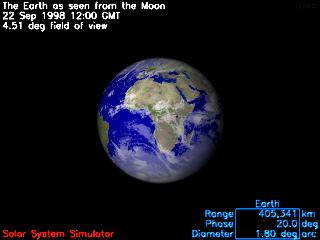 NASA / JPLSolar System Simulator
NASA / JPLSolar System Simulator
Experiment 5: Empirical Formula Applied
Questions
Experiment 6: Chemical Reactions: Ions,Electrolytes,
Conductivity, Salt Farming / Applied
Questions
Experiment 7: The Nine Solution Problem
Experiment 8: Thermochemistry, Applied
Questions
Experiment 9: Ethanol Distillation & Analysis:
Alcoholic Beverage Analysis [QT Movie]
Oxidation-Reduction / Titration Lab
Ethanol
Analysis: Web Reading List; Applied
Questions
Experiment 10: Calibrated Peer Review (CPR):
Writing Assignment, Chemical Properties &the Periodic
Table
CPR:Calibrated
Peer Review
Experiment 11 (Webshop): Greenhouse Gases II & III, VSEPR,
(Valence
Shell Electron Pair Repulsion "Theory")
Global Warming / CO2
 IR Energy Absorbtion / Molecular Motions
IR Energy Absorbtion / Molecular Motions
Experiment 12: Percent Magnesium
in a Mixture: Quicktime
Illustration; Molecules in Motion
Experiment 13: Ethyl Acetate Hydrolysis / theEquilibrium
Constant Equilibrium Problems


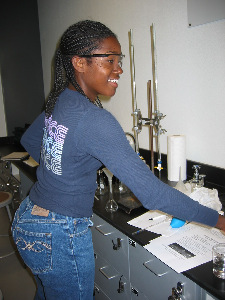
Experiment 14: Haber Process Group Project

Fritz
Haber, Nobel Prize in Chemistry 1918: "for the synthesis of ammonia
from its elements"...."From the law of equilibrium it follows that the higher
the pressure is the more the equilibrium must shift to the ammonia side.
This provided the basic principles. A temperature of about 500° C had
to be used at the highest possible pressure, which in practice meant at
about 150-200 atmospheres. It could also be assumed that this high pressure
speeded up the reaction. But work with a flow of gas in a circulation system
at such high pressure and at a temperature approaching red heat posed very
severe difficulties and up to then had never been tried. It was, however,
completely successful. The treatise in question contains detailed drawings
of the equipment used with which, using iron as a catalyst, about 250 grams
of ammonia were produced per hour and per litre of contact volume; with
uranium or osmium as a catalyst considerably more was produced."
Photo and complete award description, from The
Electronic Nobel Museum Project developed by The Nobel Foundation:
http://www.nobel.se/chemistry/laureates/1918/
Reading
on Recent Advances: NH3 / Solid State Chemistry

http://news.bbc.co.uk/hi/english/special_report/1998/10/98/world_war_i/newsid_197000/197437.stm
The image gives a hint to the answer of the last question of the worksheet.
Click on the image / link for BBC's "tour de force" of WW I. The 80th anniversary
of its end was on the 11th hour of the 11th day of the 11th month of 1998.
The 11th day of the 11th month is celebrated in the U.S. every year as Veteran's
Day. Veterans and anyone who have experienced the horrors of war share an
enormous bond of remembrance regardless of the conflict or the country. A
WW I's officer's poetry reflects an Englishman's experience in 1918. Read
one of his poems, "Dulce et Decorum Est", which
also relates to the on-line equilibrium problems last question. A bonus will
be given for a correct English translation of the poem's Latin close: "Dulce
et decorum est pro patria mori." and explaining why you agree or disagree
with this sentiment.
Acids & Bases:
Experiment 15: Indicators & General Acid-Base Principles
Fluid Exchange: Communicability/ Epidemiology/
Acids-Bases
Biological Equilibrium: Climbing Mt. Everest
Experiment 16: Quantitative Analysis of (KHP),
potassium (K) hydrogen (H) phthalate (P)
Related & Combined Experiments:
End of Course Survey:
(Anonymous survey):
http://www.wcer.wisc.edu/salgains/student/
© Copyright 1998-2012 R.J. Rusay
Chem 120 Topics & Assignments:

